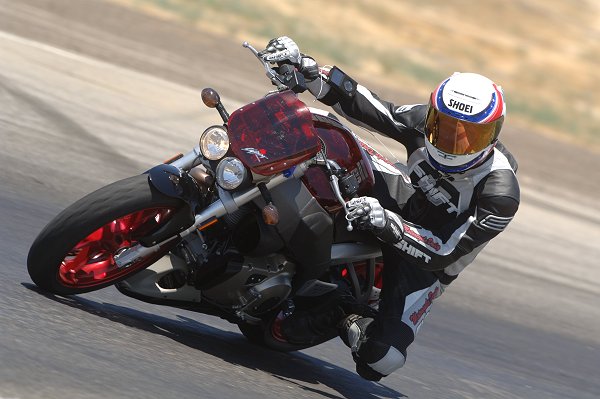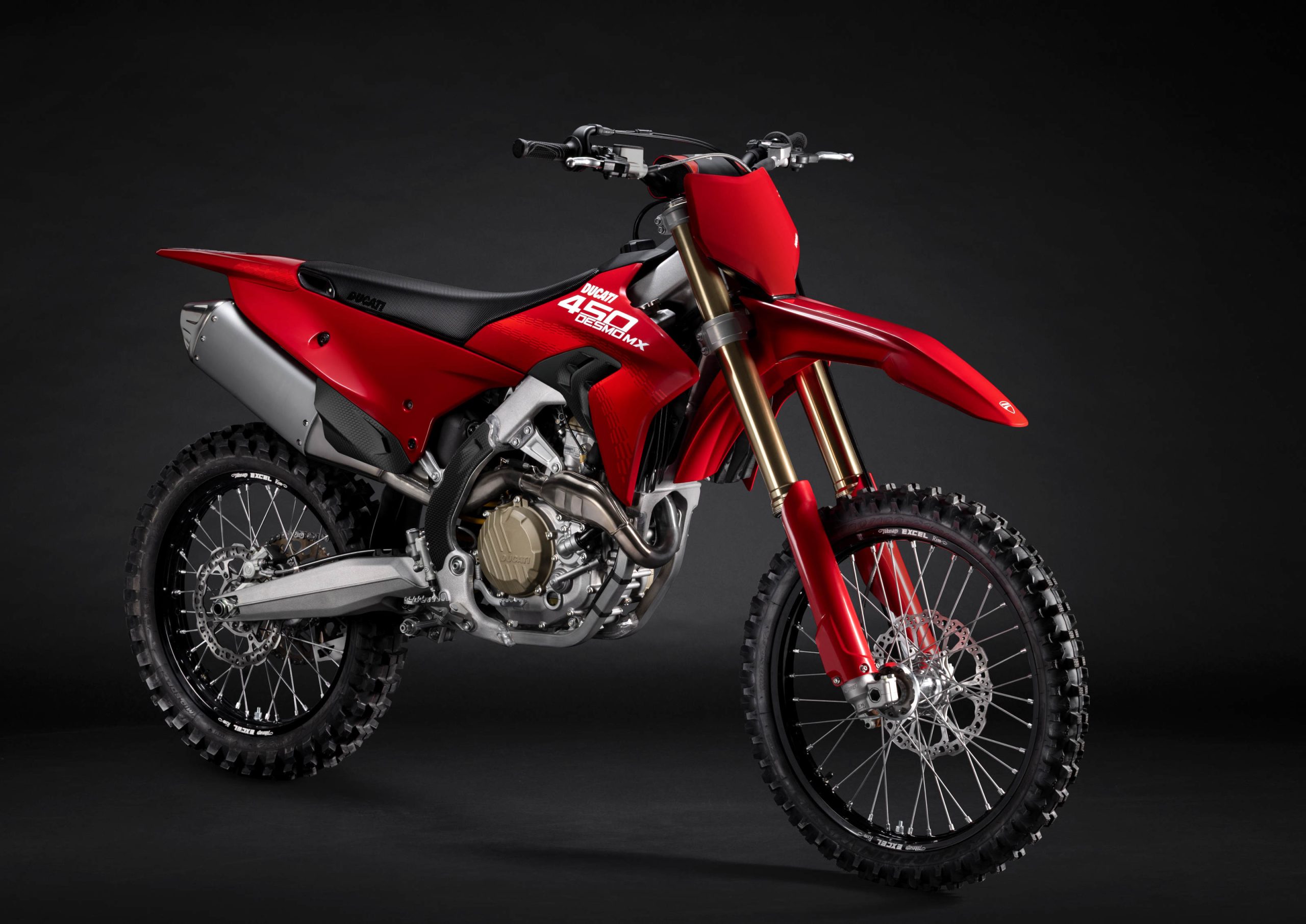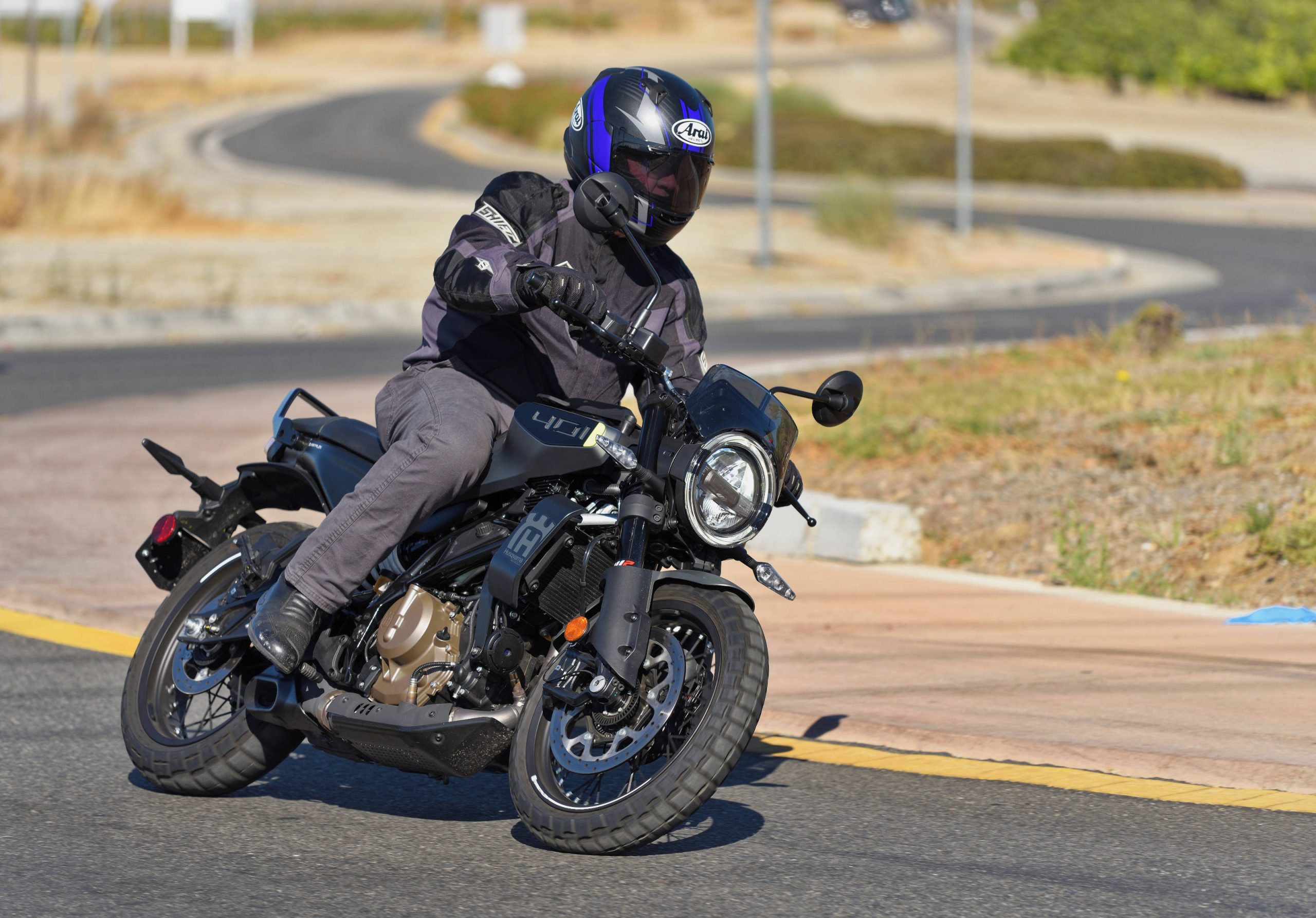
In a market dominated by inline four-cylinder, liquid-cooled, overhead cam 600cc supersport bikes, Buell’s XB models certainly stand out from the crowd. The first time you see one (or take a look at the specs), you might be a little confused. A compact sportbike (and it’s ‘streetfighter’ variation) powered by an air-cooled V-Twin featuring pushrod valve actuation (and derived from the engines of Buell’s parent company, Harley-Davidson)? How does that work?
The short answer is, pretty damn well. But before we get into a more detailed riding impression, it’s important to spend some time outlining the features and specifications of the XB model range.
According to Erik Buell (company founder and himself a talented designer and engineer), when he and his design team first put pen to paper with the XB series, their concept was to create a motorcycle that ‘does exactly what you expect it to’, and responds to rider inputs ‘accurately, predictably, and immediately’. To that end, they developed what they call the ‘Buell Trilogy of Tech’ – three underlying principles that Buell’s designers feel are the keys to building a bike that meets their stated goals.
The first part of the ‘Trilogy of Tech’ (hereafter referred to as ‘ToT’) is mass centralization. According to Buell, proper location of a motorcycle’s many components is critical to building a bike that provides effortless direction changes and promotes rider confidence in turns. A close examination of any of the XB models reveals that almost every piece on the bike has been developed with mass centralization in mind, but there are a few outstanding examples.

The muffler is mounted at the lowest, most central point on the bike – running directly under the engine, and ending near (but below) the rear swingarm pivot point. Rather than using a traditional high-mounted fuel tank, the XBs store this most precious (and expensive) of liquids inside the spars of the massive aluminum perimeter frame, allowing a good portion of the fuel load to be carried lower, while at the same time leaving room for a large-volume airbox where the fuel tank would normally be located (Buell says the larger airbox volume helped them produce more power from the V-Twin engine). The engine’s oil reservoir is also creatively conceived; the forward portion of the XB’s aluminum swingarm doubles as an oil tank, allowing Buell to do away with the separate oil tank that has been a feature on every Harley-powered machine for many decades. Thus the weight of the oil is also carried extremely low, and don’t worry – being located extremely close to the swingarm’s pivot point means the oil has a negligible affect on unsprung weight.

Speaking of unsprung weight, it comprises the second part of the ‘ToT’ – that is, low unsprung weight. Decreasing unsprung weight makes it easier for the suspension to damp the motion of the wheels, which pays dividends in the form of handling, stability (particularly over the unavoidable mid-corner bumps), and even straight-line ride quality.
Again, Buell’s design team thought outside the box when it came to decreasing unsprung weight, and what they came up with is now known as the Zero Torsional Load (ZTL) braking system – one of Buell’s many patented innovations. In a normal braking system, the discs are mounted to the wheel’s hub, which means that braking forces have to travel through the wheel’s spokes in their path from the disc to the tire. Buell’s solution was to mount the disc directly to the outer rim of the wheel, giving a much more direct path for braking forces, and allowing a much lighter wheel to be used without any compromise in strength. The larger diameter rotor also provides much greater leverage, allowing Buell to use only a single rotor/caliper rather than the paired setup found on most other sportbikes. Reaching back into ancient history, Buell even claims to have been the first manufacturer to introduce a production street motorcycle with inverted forks – way back in 1991. All this combines to keep the unsprung weight on the XB models to a bare minimum. During the tech presentation, we had a chance to make a direct comparison (read ‘we picked them up’) of the weight of an XB front wheel with disc versus that of a competitor’s 600cc sportbike, and trust me, the XB wheel was MUCH lighter.
The final part of the ‘ToT’ is chassis rigidity. This may come as a surprise given the volume of recent discussion regarding ‘tuned flex’, but Buell’s engineers still believe that the best frame is the most rigid frame. That led to the aforementioned massive spars of the XB’s aluminum perimeter frame, and the entire construction of the XB provides extreme structural rigidity. Buell claims that this rigidity contributes to the precision handling of their chassis; we said prove it, and they did. But you’ll have to wait til later to read about that.

The XB’s rigid chassis is connected to the wheels by means of Showa suspension at both ends – 43mm inverted forks up front, and a remote-reservoir monoshock at the rear. The rider who values suspension adjustability will find plenty of it here – both the forks and shock are adjustable for compression and rebound damping, as well as preload.
The final innovation we’d like to mention is just that: final. Final drive, that is. You see, rather than using the more typical chain-and-sprocket arrangement, Buell opted to develop what they call the Buell Immediate Throttle Response System – a belt final drive with an idler pulley that maintains constant tension in the drive belt, which is supposed to eliminate the driveline lash and hesitation that sometimes result from the changing tension of most belt- or chain-drive systems, where the fact that one sprocket stays stationary and the other swings in an arc results in varying tension depending on the swingarm’s position in its stroke. Another benefit of the belt drive system is that it requires (according to Buell) absolutely zero maintenance – the tension never needs adjusting, and the belt has been tested to last more than 100,000 miles (barring outside damage, which could result from a rock going through the drive, or some similar incident).
The final part of the XB equation is obviously the powerplant. Both XB models (the faired ‘R’ model, known as the Firebolt, and the streetfighter-style ‘S’ model, called the Lightning) are available with one of two engines – the ‘9’ powerplant (actually displacing 984cc) and the ’12’ (1203cc). The two powerplants are extremely similar, with the 12 being little more than a 9 with a longer-stroke crankshaft. Both are air/oil-cooled 45 degree V-Twins, with the centrally-mounted camshaft actuating the two valves per cylinder by means of a traditional pushrod system. Both motors feature 10:1 compression, and are fuel-injected by means of a single large-diameter downdraft throttle body (45mm on the 9, 49mm on the 12). Buell claims the 984cc motor produces 92hp@7500rpm and 70 ft-lbs of torque at 5500rpm, while advertising the 1203cc version as having an output of 103hp@6800rpm and 84 ft-lbs of torque at 6000 rpm.
So how does Buell’s combination of innovative chassis design and a big, torquey Harley-Davidson based power plant work in the real world? We got the chance to sample the 2007 Buell lineup over 2 days of riding in the Bakersfield, California area – one day on the twisty back roads near Lake Isabella, and one day circulating nearby Buttonwillow Raceway.

First, a few words about the different Buell models. As I mentioned earlier, there are two primary variants of the XB – the street fighter style Lightning (designated XB9S or XB12S, depending on which motor you opt for), and the sportier Firebolt (XB9R or XB12R), which features clip-on handlebars and a half-fairing as opposed to the miniscule fly screen of the Lightning. Other than slight differences in riding position and appearance, the two chassis are functionally identical. So while I spent the majority of my time on the Lightning, most of what I have to say here should apply to the Firebolt as well.
With a wheelbase several inches shorter than that of most current 600cc supersport machines, combined with aggressive chassis specs (21 degree rake, 83mm trail), I expected the Firebolt to be quick-handling but nervous. The former is certainly correct, while the latter characteristic is also present to a certain extent, but much less prominent than I expected.

The Firebolt turns in sharply and cleanly, and gives the rider confidence to quickly move to extreme angles of lean. Once set into a turn, the Buell holds a line with confidence and always gives the impression that there is plenty of grip left – even when you’re dragging both your knee and toe sliders, as I found myself doing through Turn 2 at Buttonwillow, a long, slightly off-camber 180 degree right hander taken in second gear.
The chassis never feels nervous on rough, bumpy roads, but a minor amount of headshake can be felt when making abrupt shifts under hard acceleration. However, a slight change in riding style eliminated this problem entirely – I simply began dedicating a tiny bit more attention to making smooth shifts.
Tight corners and sections requiring frequent direction changes are the Firebolt’s strong point – the bike flicks from full lean to full lean crisply and with minimal effort. The XB12S is a fair bit heavier than some of the competition (about 15-30 pounds heavier than a Japanese 600, based on claimed dry weight), but Buell’s emphasis on mass centralization seems to have paid off – the XB12S feels as light or lighter than most of the 600s I have ridden lately.
The major change to Buell’s 2007 line-up was a move to Pirelli tires across the board; the Lightning and Firebolt are fitted with a new version of Pirelli’s popular Diablo, the Diablo T. According to both Buell and Pirelli engineers, the two companies worked together closely to develop a tire with characteristics that suited the Buell XBs (including low unsprung weight), and these claims were supported both by the performance of the tires, and the presence at the intro of one of the leading test riders from Pirelli’s European headquarters – he traveled all the way to California to answer our questions about the Diablo T (whose developement he was heavily involved in).
As I said, the performance of the Diablo Ts lived up to Buell and Pirelli’s claims – the tires warmed up quickly, changed direction easily, and had plenty of ultimate grip (at least for a rider of my speed). Basically, they worked perfectly with the XB’s chassis. The Diablo Ts also provided tons of feedback, particularly at the front end, which is extremely important for rider confidence.
Another reason the XB12S excels in tight corners is the character of the 1203cc V-Twin power plant. In sections where a series of tight, slow corners are separated by extremely short straightaways, the midrange torque is perfect for squirting the XB from corner exit to corner entry. However, once the road opens up, the big V-Twin starts to struggle – in faster sections, I frequently found myself with the throttle wrung all the way to the stop.
I didn’t get a chance to ride the 984cc-powered XB models, but considering the appealing torque of the bigger motor, I can’t see why anyone would choose the 9 when the 12 is available. The 1203cc motor certainly isn’t ‘too powerful’ – the power delivery is smooth, predictable, and extremely easy to modulate. One of the things that impressed me the most about the XB12S was the perfection of the fuel injection mapping, which primarily manifests itself in the seamless transition from closed to open throttle – one of the best I have experienced on any fuel-injected motorcycle.
The big 1203cc V-Twin also has surprisingly little engine braking. There’s enough there that you can use it to your advantage when slowing for turns, but not so much that it makes the bike difficult to ride smoothly. I say this is surprising because many of the big-displacement V-Twins I have ridden, and even some of the little ones (umm, SV650) have a very noticeable amount of engine braking. Some riders like this, some don’t – register me in the ‘don’t’ column. The engine braking of Buell’s V-Twin, however, is ‘just right’, at least in my opinion.
When engine braking just isn’t enough, it’s time to test out that sexy-looking ZTL front brake. At first glance, you might wonder if the single rotor/caliper setup can match the more common dual disc configuration for stopping power. Well, wonder no more – from the rider’s perspective, the brakes on the Buell XB are awesome, with excellent feel and modulation, and great stopping power as well.

The ergonomics are comfortable enough for a sport bike, particularly on the Lightning, with its upright seating position and wide, dirt bike style handlebars. The seat is excellent as well – I loved the hump that kept me from sliding back too far! Buell engineers claim to have designed the XB’s seats with some kind of advanced computer modeling/simulation program, and it seems to have worked.
One thing about the XB that stood out was the excellent ride quality, which is a natural product of Buell’s quest to reduce unsprung weight. Despite being sprung and damped stiffly enough to handle aggressive riding, the XB rides extremely smoothly over bumps, potholes, and generally beat up pavement. Of which there seems to be a lot in the Bakersfield area – apparently the Governator’s road repair team forgot about the Central Valley!





